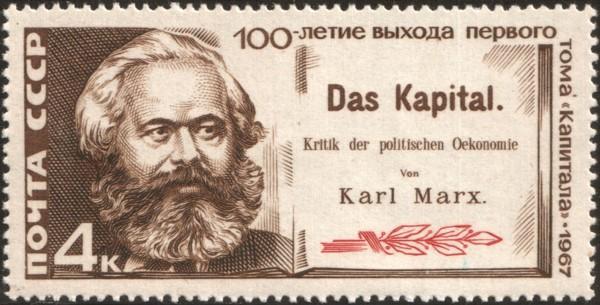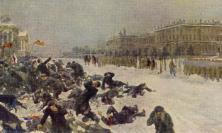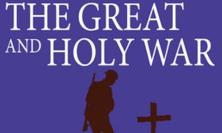2017 was not only the centenary of the Russian Revolution; it also marked 150 years since the publication of Karl Marx’s Das Kapital. To what extent did that work shape the social and political landscape in Russia in the years leading up to 1917? Dairmid Gunn explains how Marxist thought tapped into stirrings among the Russian intelligentsia.
The centenary of the Russian Revolution fell in the same year as the 150th anniversary of the publication of Karl Marx’s famous work, Das Kapital. Its theories and analyses were to influence Russian political thought in revolutionary circles in the late nineteenth and early twentieth centuries, and have a significant bearing on the events leading up to the Revolution and its outcome.
The influence of Das Kapital was strengthened by the turbulence of the three unsuccessful wars waged by Russia during the period in question; the maxim that wars engender change could be applied most aptly to Russia. The Crimean War (1853-56), the Russo-Japanese War (1904-05) and the Great War were stimuli for far-reaching changes in the political structure of a country that tried throughout to preserve its autocratic regime. The philosophy of Marx, or Marxism, had fruitful soil on which to grow and become a vital ingredient in the overthrow of autocracy.
The Crimean War fought on the Russian peninsula of that name between the armies of Russia and those of Britain and France ended in a military disaster for Russia with the loss of its vitally important port of Sevastopol and the end of its maritime aspirations in the Black Sea and the Mediterranean. The defeat of Russia on its own soil led to a period of social unrest and criticism of autocratic rule. Alexander II, although more liberal than his father, Nicholas I, still believed that autocracy was the only form of government for his vast country but accepted that, in order to preserve it, changes were necessary. In 1861, he passed a law that emancipated the serfs or peasant workers, who previously had no rights and could be bought and sold by the proprietors of the land on which they worked. Under the new law, parcels of land were allocated to them for purchase through loans from financial institutions, so they were socially free but often tied economically to their former proprietors. Efforts were made to improve the general conditions of rural Russia through the formation of zemstvos or country councils, which introduced more advanced farming methods, built new schools and improved the state of the roads. Despite the work of these bodies, there was still deep discontent among the peasantry; they wanted more land and land freely distributed.
The publication of Das Kapital in 1867 did not have the explosive effect that could have been expected. At that time, Russia was essentially an agricultural country, and Marx’s ideas were more relevant to countries with a wide industrial base. This did not mean that the ideas expounded by Marx were of little interest to thinking people throughout the country, the intelligentsia, who enthusiastically imbibed philosophical and political ideas from the West. Such names as Schopenhauer, Comte, Hegel and Darwin were the currency for endless discussions on what could be done to improve the wellbeing of their country; ideas varied, but the general aim was that autocracy had to end. As the county became more industrialised in the late 1870s, interest in Das Kapital grew accordingly. The advent of better communications, including the development of a railway network, helped the dissemination of ideas.
The intelligentsia may not have had either organisation or point of focus but it was a source of recruitment for active revolutionary groups. The ideas of the intelligentsia met with stiff resistance from a section of society that clung to the concept of a Russia that had preserved its individuality and unique status through the spiritual and traditional roots nurtured by its Church and rural communes, and by its loyalty to the tsar. The so-called Slavophiles, who were the dominant group in the Federation of Zemstvos, regarded the intelligentsia as a movement tainted by materialism and atheism.
The assassination of Alexander II in 1881 by members of a revolutionary group for land reform had serious repercussions for any form of political activity of which the state disapproved. Revolutionary groups within Russia were ruthlessly suppressed. This had no effect on revolutionary activity abroad. In 1883, a group known as the Liberation of Labour was formed in Switzerland by a Russian, Georgi Plekhanov, with the views that social revolution would be achieved by the industrial proletariat and not by the peasantry, and that political struggle and not terror would be the means to this end. Marxism had taken root, and Georgi Plekhanov could justifiably be called the father of Russian Marxism.
In 1898, a Russian party that adhered to Plekhanov’s beliefs, the Social Democratic Labour Party, was formed. In 1903 there was a split between those in this party who wanted a disciplined and dedicated form of membership and those who wished a more liberal and international approach. The former won the vote and took the name of ‘Bolshevik’ (majority), and the defeated the name of ‘Menshevik’ (minority). The leader of the Bolsheviks, Vladimir Ulianov, better known by his pseudonym, Lenin, was an ambitious and autocratic man in his early thirties, who based himself abroad during these years to devote himself to developing a strategy for his newly formed party.
1903 was also an important year in the industrialisation of Russia, a year that saw the completion of a railway line connecting St Petersburg and Moscow to the Pacific port of Vladivostok. The Trans-Siberian railway opened up the thinly populated eastern part of Russia, and the commercial possibilities of that remote region were inviting. But Russian expansionism clashed with that of a fast growing Asian power, Japan. A war was inevitable and broke out in 1904. 1904/05 saw a series defeats for Russia on land and at sea. As with the Crimean War, the loss of prestige for Russia caused by military defeats was immense both at home and abroad, and matters were worsened internally by the Bloody Sunday incident of January 1905 in St Petersburg.
To restore some form of order, the tsar had to make a positive response. He did so by making concessions to popular demands in the form of a manifesto, the October Manifesto of 1905. The most important concession in this historic document was the creation of a duma or parliament that would have strong legislative powers, It was the first of four dumas that were to meet until the outbreak of the First World War in 1914. Although the dumas were subject to continual interference from the tsar and his ministers, they did provide a platform for tempering the more extreme policies introduced by those ministers. Representation in the dumas was not confined to overtly revolutionary parties. Many of the seats were occupied by the more liberal parties such as the Constitutional Democratic Party (the Cadets) and the Octobrists, who were both striving for a form of constitutional monarchy. The strictly Marxist Bolsheviks were poorly represented, having only 15 out of a possible 448 seats in the fourth duma. They remained a tightly knit party, which operated largely from abroad. The aim of most of the parties in the dumas was to prepare the way for the election of a constitutional assembly with considerably greater powers than those accorded to the dumas.
Despite the low level of representation of the Bolsheviks in the dumas, the general philosophy of Marxism was widely discussed in the intellectual circles of St Petersburg and Moscow as a possible way ahead for the country. To counter atheistic and materialistic political thinking, the Orthodox Church was bent on a change of policy that would place more emphasis on social activities; these would include the strengthening of the structure of parish communities, the formation of parish schools and the participation of the clergy in the work of secular organisations. It also advocated the restoration of the patriarchate, which had been in abeyance since the time of Peter the Great. Such moves engendered a negative response from the tsar and his ministers, who saw the restoration of the patriarchate as a move to lessen the power of the state over the Church. But the publication of the papers from a 1909 symposium on social matters, which were widely circulated and well received by many influential figures, did give the Orthodox Church a bit of a fillip.
By 1913, there was a definite expectation of change, but change engendered democratically and peaceably. The year itself saw celebrations connected with the tercentenary of the House of Romanov with one of the more impressive events being a magnificent ball in the Winter Palace. But change came more quickly than expected, and more brutally. In 1914, Russia entered what was to become known as the Great War.
Initially, the country was engulfed in a wave of patriotism. The German sounding name of St Petersburg was changed to the more Russian ‘Petrograd’. The duma and the Federation of Zemstvos combined in efforts to ensure that the army was provided with the necessary equipment and supplies. Patriotic fervour only began to die when the army sustained a series of defeats and food shortages began to be experienced in the big cities. Matters took a turn for the worse when the tsar, a ruler without any military experience, appointed himself as commander-in-chief of the Russian army. The vacuum created by his absence from Petrograd was filled by the Tsarina Alexandra and her council of ministers, and by the notorious Gregory Rasputin, whose eventual assassination by a group of aristocrats in December 1916 did little to stabilise the chaotic and restless state of the country. The army was being defeated; deserters were returning in hordes to their villages; there were serious bread shortages and the police in the big cities were finding it difficult to maintain law and order. The city soviets (workers’ councils) were gaining in strength and importance. Members of the fourth duma, which had dissolved itself, formed a provisional government to manage the country while co-existing with the tsar and his council of ministers. In February of 1917, when the governance of Petrograd was virtually out of control, representatives of the provisional government and the Petrograd soviet on which it was heavily dependent confronted the tsar and forced him to abdicate. The provisional government became the de facto government of Russia. Lenin, who was abroad at that time, played no role in these dramatic events. In April 1917, the Germans, who were aware of Lenin’s dynamism and leadership qualities and who wished Russia’s withdrawal from the war, engineered his return to Russia via Finland. On his arrival in Petrograd, Lenin quickly assessed the situation and saw the opportunity to stage a coup d’état and establish his Marxist Bolshevik party as the ruling group within the revolutionary parties. He chose as his vehicle for this bold action the Petrograd soviet, which had within its membership soldiers from the city garrison. On 7 November 1917, the coup was executed with military efficiency and with little loss of life. The great October (Julian calendar) Revolution had taken place.
The provisional government was replaced temporarily by a Bolshevik-dominated body of soviets from the main cities called the Soviet of the People’s Commissars (Sovnarkom). It quickly issued two decrees. The first was an appeal to all peoples at war and their governments to begin negotiations for a just and democratic peace. The second was to abolish all private ownership of land pending the decision of the still-to-be-elected constitutional assembly. The emergence of Sovnarkom did not obviate the need for the election of a constituent assembly of parties across the political spectrum to ensure a smooth path to a democratic Russia. The duration of the constituent assembly, which was convened on 18 January 1918, was one day. Surrounded by Bolshevik guards from the Petrograd soviet, it was dissolved with no prospect of reconvening. Leadership of the country was moved irrevocably to a congress of soviets, which was to give birth to the Russian Socialist Federative Republic, a republic directed and controlled by the Bolsheviks under their new name of the Russian Communist Party
Throughout the early years of the twentieth century, Lenin had followed Marxist philosophy and had initially accepted the belief that the revolution had to be a transition from autocracy to communism in stages, one such stage being democratic government on an industrial economic base. Contrary to this prediction, in Russia the proletarian revolution had taken place without going through a period of Western style parliamentary democracy. The industrial base on which to build socialism had still to be created. Thus the country embarked on a Marxism turned upside down. Lenin imposed upon the Russian Revolution the particularly Russian scheme of Communism, theoretically known as Marxism-Leninism – a Das Kapital tailored to meet Russia’s needs.
Dairmid Gunn is a vice president of the Scotland-Russia Forum, a charitable organisation dedicated to improving understanding between the two countries through cultural exchanges and contacts of all kinds on a non-political basis. In his career in the Royal Navy he served as a naval attaché in the British Embassy in Moscow in the 1960’s. He is a fluent Russian speaker.






